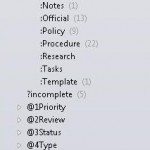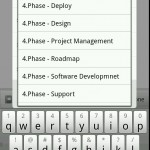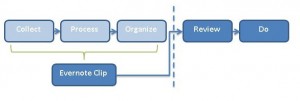This is the first of a series of tutorial like posts that will follow concerning how to get organised with Evernote.
There are a lot of methods that people use for getting organized, each having its own pros and cons. When it comes down to actually putting the methods into actions there is no right or wrong, rather it depends on the individual (or group). There are some basic characteristics one should take into account though. For example spending less time in organizing stuff and more on actions, or taking less time on retrieving information.
That is exactly what GTD by David Allen is trying to achieve. Free time, mind and energy from the administrative tasks of getting organized so that we can concentrate in actually doing stuff. Its workflow asks you to Collect staff where you put everything in a Mary Poppins kind of bug (Inbox), Process it where you separate stuff into Trash, Review, Reference or Tasks, if it is a task Organize it with some very basic actions Do, Delegate, Deffer, Review from time to time and finally actually Do the task.
There are tons of articles out there about GTD so I will not go deeper than that. Instead I am going to present my own little methodology based on GTD, with a little help from Evernote. I will explain how I reduced the amount of information I need to remember and the amount of time I need to retrieve information. Also I will try and explain how I reduced the amount of time needed for storing and organizing my stuff in Evernote. In future posts I will present more specific methods of how to use Evernote, for example for Task Management or Filing, but to do that I need to explain the methodology first.
Tags
The first thing that attracted me to Evernote was the ability to assign Tags to notes. Tags are really the key to Processing and Organizing stuff, as they allow you to organize your notes both horizontally with multiple tags and vertically with sub-tags. This feature allows me to assign the same Tags in different type of information. For example I can have a notes under the “Project A” with tags “:Meeting” or “:Documentation” or even “:Task“… by the way “Project A” is also a Tag. There are infinite combinations you could have for organizing your notes. Tags also reduce the amount of information you need to remember and the amount of time you need to retrieve the required information. For example in order to find all the tasks specific to a certain project I search for tag:”:Task” tag:”Project A”. I only need to remember the project name and the keyword Task (in case i forget i can simply look at the tags tree in Evernote).
Lets stop here and think about the above example for a minute. The traditional way would have been to create different system folders for each project, and under each project folder create sub-folders specific to the type of content (Tasks, Documentation, Communication and so on). There would be no easy way though of finding all the Documentation documents specific to a certain technology in all projects. Imagine having to find all the Communication for a project, both electronic and on paper. With Evernote you can easily scan your document (there are even scanners that scan directly to Evernote, or use mobile apps like CamScanner that scan from your mobile) and tag them with the project, or if you want you can keep the paper documents stored somewhere and use Evernote notes to track those documents in storage. By using Tags you are not restricted by any hierarchical tree structure.
Clip
The second thing that stands out in Evernote is how easy it is to collect notes from a variety of sources. You can do it through your browser, you can do it from the application’s interface, you can clip your emails from outlook, you can send an email and add notes to Evernote, take a photo or record sound from your smartphone… and many many more ways of collecting notes, the number of which grows constantly as more and more 3rd party applications or hardware add Evernote support.
Clip n Tag
As you might have noticed in the tags structure images above, I have am stating most of my tags either with either a symbol or a number. In this example setup my tags start with the following characters (tags should be specific to your needs and to your retrieval queries):
- “:” defines for Type of stuff
- “@” concerns Tasks (I will elaborate on that in a future post).
- “1” defines Department
- “2” defines Role
- “3” defines Project
- “4” defines System
- “5” defines Technology
 By doing that when adding a note, I simply type that first character in the tags box and I get the list of entries concerning that group of tags. So typically when adding a note, I type “:” and select the type of stuff to be saved from the dropdown (see image on the left), then I do the same going through 1 – 5 and have a complete categorization of my note, and all that within seconds. Note that typing extra characters will filter the Tags starting with those characters, just like in Facebook search, so you can find the Tag you want even faster. You can do the same when adding a note from the browser or your mobile (see images above).
By doing that when adding a note, I simply type that first character in the tags box and I get the list of entries concerning that group of tags. So typically when adding a note, I type “:” and select the type of stuff to be saved from the dropdown (see image on the left), then I do the same going through 1 – 5 and have a complete categorization of my note, and all that within seconds. Note that typing extra characters will filter the Tags starting with those characters, just like in Facebook search, so you can find the Tag you want even faster. You can do the same when adding a note from the browser or your mobile (see images above).
The key here is that I have set up my Tag names in a way that I can categorize my notes really fast and without having to review my inbox from time to time. I don’t even have to remember the category types, I simply type :,1,2,3,4,5… its that simple.
Workflow
Notice I have underlined the words Collect, Process and Organize in the above paragraphs. As I have demonstrated it is possible to perform all three actions while collecting, by using Evernote and having a good Tag structure. So immediately I have reduced the number of steps for getting organized to 3 Evernote Clip, Review and Do. In later posts I will demonstrate how you can use Evernote’s search to reduce the Review time as well. So here is my revised 3 step workflow:
Evernote has other noticeable characteristics like having mobile, web and desktop clients. The ability to work both offline and online and sync through all devices. Collaboration features though this is limited to premium users. In general Evenote fulfills most of my requirements as described in Productivity Services 101. Stay tuned for more posts about getting organized with Evernote.
Sources:






This is exactly what I’ve been looking for. Thanks for the post, Constantinos. Going to give it a test-drive over the next few weeks and will keep you posted.
Best from Paris, Brad
Glad to hear that, let me know how it goes. I’ll try and write more specific examples such as how I handle Task Management
Nice. Now subscribed to your blog, so look forward to hearing more. Cheers.
Pingback: gieglas.com » Getting Organized with Evernote – GTD Task Management
Pingback: gieglas.com » Evernote – Life Work Balance